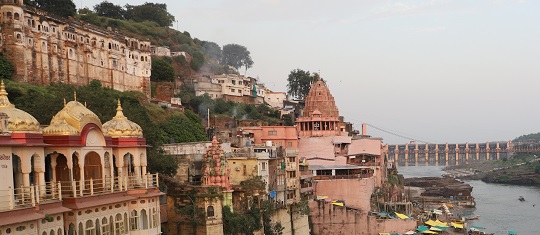Shri Omkareshwar Jyotirling

Kaaverikaa Narmadyoh Pavitra Samaagame, Sajjan Taaranaaye |
Sadaiva Mandhaatrapure Vasantam, Omkaarmeesham Shivayekameede ||
At the sacred confluence of the Kaveri and Narmada rivers, Bhagwan Omkareshwar, who is self-manifested, resides eternally in the city of Mandhata, also known as Shivpuri, and is the Jyotirlinga. This verse is composed by Adi Shankaracharya.
Omkareshwar Jyotirlinga is situated on the banks of the Narmada River in Madhya Pradesh, 77 km from Indore and 13 km from Mortakka. Here, the Narmada River splits into two parts, creating an island called Mandhata or Shivpuri, which is about 4 km long and 2 km wide. The shape of this island resembles the visual form of "Om" or "Omkar". According to the Puranas, the Vindhya Mountain performed penance and worshipped Bhagwan Shiva in the form of a physical lingam, after which Bhagwan Shiva appeared and blessed the mountain, manifesting as the Pranav Lingam. It is also said that after the prayers of the gods, the lingam was divided into two parts: one became Omkareshwar and the other, Mamleshwar. The Jyotirlinga is located at Omkareshwar, while the physical lingam is at Mamleshwar or Amreshwar. According to another version, King Mandhata of the Ikshvaku dynasty meditated here, and Bhagwan Shiva appeared and blessed him, which is why Bhagwan Omkareshwar resides here.
Architecture
The main temple of Omkareshwar is constructed in North Indian architectural style with a high spire. It remains the main attraction for devotees. There is no authentic record of who built the temple or when, making its history unknown. The sanctum, built in an older architectural style, resembles a smaller temple. Its dome is made of stone layers. This small temple, located on the southern edge of the river's deep bank, faces north, while the larger, newly constructed part of the temple faces south. This might explain why the sanctum and the main deity are not aligned directly with the main door or the top spire of the new construction.
The temple has a vast assembly hall, nearly 14 feet high, supported by 60 massive pillars. The temple has five floors, each dedicated to a different deity: Shri Omkareshwar, Shri Mahakaleshwar, Shri Siddhnath, Shri Gupteshwar, and the Flag-bearing deity at the top.
Pujan And Palki
There are three daily rituals at the temple: the morning prayer is conducted by the Trust, the afternoon prayer by the priests of the Scindia family, and the evening prayer by the priests of the Holkar family. The temple is always crowded with devotees who bathe in the Narmada River and offer water-filled containers, flowers, coconuts, and other offerings to the Bhagwan. Many devotees also perform special worship and Abhishek (ritual bathing) with priests. During festivals and fairs, the crowd is even larger.
Every Monday, a beautiful golden palanquin with a three-faced statue of Bhagwan Omkareshwar is carried in a procession, accompanied by drums and cymbals. This procession is known as the "Dola" or "Palki" and starts with worship by the riverbank, after which it proceeds through different parts of the town. This procession is especially grand during the holy month of Shravan, with devotees dancing and chanting "Om Shambhu Bhole Nath", creating a vibrant atmosphere.